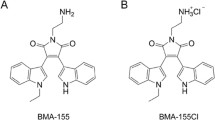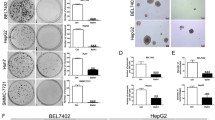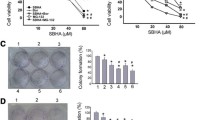Abstract
Histone deacetylase (HDAC) inhibitors represent a promising group of anticancer agents. This paper shows that the HDAC inhibitor suberoylanilide hydroxamic acid (SAHA) stimulated at 5–10 μM apoptosis in human hepatoma HepG2 and Huh6 cells, but was ineffective in primary human hepatocytes (PHH). In HepG2 cells SAHA induced the extrinsic apoptotic pathway, increasing the expression of both FasL and FasL receptor and causing the activation of caspase-8. Moreover, SAHA enhanced the level of Bim proteins, stimulated alternative splicing of the Bcl-X transcript with the expression of the proapoptotic Bcl-Xs isoform, induced degradation of Bid into the apoptotic factor t-Bid and dephosphorylation and inactivation of the anti-apoptotic factor Akt. Consequently, SAHA caused loss of mitochondrial transmembrane potential, release of cytochrome c from mitochondria, activation of caspase-3 and degradation of PARP.
Interestingly, a combination of suboptimal doses of SAHA (1 μM) and bortezomib (5–10 nM), a potent inhibitor of 26S proteasome, synergistically induced apoptosis in both HepG2 and Huh6 cells, but was ineffective in PHH. Combined treatment increased with synergistic effects the expression levels of c-Jun, phospho-c-Jun and FasL and the production of Bcl-Xs. These effects were accompanied by activation of Bid, caspase-8 and 3.
In conclusion, SAHA stimulated apoptosis in hepatoma cells and exerted a synergistic apoptotic effect when combined with bortezomib. In contrast, these treatments were quite ineffective in inducing apoptosis in PHH. Thus, our results suggest the potential application of the SAHA/bortezomib combination in clinical trials for liver cancer.






Similar content being viewed by others
References
Kristeleit R, Fong P, Aherne GW, de Bono J (2004) Histone modification enzymes: novel targets for cancer drugs. Expert Opin Emerg Drugs 9:135–154
Somech R, Izraeli S, J Simon A (2004) Histone deacetylase inhibitors–a new tool to treat cancer. Cancer Treat Rev 30:461–472
Peart MJ, Smyth GK, van Laar RK et al (2005) Identification and functional significance of genes regulated by structurally different histone deacetylase inhibitors. Proc Natl Acad Sci USA 102:3697–3702
Giuliano M, Vento R, Tesoriere G et al (1999) The apoptotic effects and synergistic interaction of sodium butyrate and MG132 in human retinoblastoma Y79 cells. Cancer Res 59:5586–5595
Emanuele S, Vento R, Tesoriere G et al (2004) Sodium butyrate induces apoptosis in human hepatoma cells by a mitochondria/caspase pathway, associated with degradation of beta-catenin, pRb and Bcl-Xl. Eur J Cancer 40:1441–1452
Newmark HL, Young CW (1995) Butyrate and phenylacetate as differentiating agents: practical problems and opportunities. J Cell Biochem Suppl 22:247–253
Kelly WK, Marks PA (2005) Drug insight: Histone deacetylase inhibitors–development of the new targeted anticancer agent suberoylanilide hydroxamic acid. Nat Clin Pract Oncol 3:150–157
Kelly WK, O’Connor OA, Krug LM et al (2005) Phase I study of an oral histone deacetylase inhibitor, suberoylanilide hydroxamic acid, in patients with advanced cancer. J Clin Oncol 23:3923–3931
Kim MS, Blake M, Baek JH, Kohlhagen G, Pommier Y, Carrier F (2003) Inhibition of histone deacetylase increases cytotoxicity to anticancer drugs targeting DNA. Cancer Res 63:7291–7300
Ocker M, Alajati A, Ganslmayer M et al (2005) The histone-deacetylase inhibitor SAHA potentiates proapoptotic effects of 5-fluorouracil and irinotecan in hepatoma cells. J Cancer Res Clin Oncol 131:385–394
Marchion DC, Bicaku E, Daud AI, Richon V, Sullivan DM, Munster PN (2004) Sequence-specific potentiation of topoisomerase II inhibitors by the histone deacetylase inhibitor suberoylanilide hydroxamic acid. J Cell Biochem 92:223–237
Yu C, Rahmani M, Conrad D, Subler M, Dent P, Grant S (2003) The proteasome inhibitor bortezomib interacts synergistically with histone deacetylase inhibitors to induce apoptosis in Bcr/Abl+ cells sensitive and resistant to STI571. Blood 102:3765–3774
Pei XY, Dai Y, Grant S (2004) Synergistic induction of oxidative injury and apoptosis in human multiple myeloma cells by the proteasome inhibitor bortezomib and histone deacetylase inhibitors. Clin Cancer Res 10:3839–3852
Drexler HC, Euler M (2005) Synergistic apoptosis induction by proteasome and histone deacetylase inhibitors is dependent on protein synthesis. Apoptosis 10:743–758
Fandy TE, Shankar S, Ross DD, Sausville E, Srivastava RK (2005) Interactive effects of HDAC inhibitors and TRAIL on apoptosis are associated with changes in mitochondrial functions and expressions of cell cycle regulatory genes in multiple myeloma. Neoplasia 7:646–657
Rahmani M, Reese E, Dai Y et al (2005) Coadministration of histone deacetylase inhibitors and perifosine synergistically induces apoptosis in human leukemia cells through Akt and ERK1/2 inactivation and the generation of ceramide and reactive oxygen species. Cancer Res 65:2422–2432
Ludwig H, Khayat D, Giaccone G, Facon T (2005) Proteasome inhibition and its clinical prospects in the treatment of hematologic and solid malignancies. Cancer 104:1794–1807
San Miguel J, Blade J, Boccadoro M et al (2006) A practical update on the use of bortezomib in the management of multiple myeloma. Oncologist 11:51–61
Goel A, Dispenzieri A, Greipp PR, Witzig TE, Mesa RA, Russell SJ (2005) PS-341-mediated selective targeting of multiple myeloma cells by synergistic increase in ionizing radiation-induced apoptosis. Exp Hematol 33:784–795
Lauricella M, Vento R, Tesoriere G et al (2006) JNK and AP-1 mediate apoptosis induced by bortezomib in HepG2 cells via FasL/caspase-8 and mitochondria-dependent pathways. Apoptosis 11:607–625
Perabo FG, Frossler C, Landwehrs G et al (2006) Indirubin-3′-monoxime, a CDK inhibitor induces growth inhibition and apoptosis-independent up-regulation of survivin in transitional cell cancer. Anticancer Res 26:2129–2135
Emanuele S, Vento R, Tesoriere G et al (2002) Apoptosis induced in hepatoblastoma HepG2 cells by the proteasome inhibitor MG132 is associated with hydrogen peroxide production, expression of Bcl-XS and activation of caspase-3. Int J Oncol 21:857–865
Lowry OH, Rosebrough NJ, Farr AL, Randall RJ (1951) Protein measurement with the Folin phenol reagent. J Biol Chem 193:265–275
Lauricella M, Vento R, Tesoriere G et al (2001) pRb suppresses camptothecin-induced apoptosis in human osteosarcoma Saos-2 cells by inhibiting c-Jun N-terminal kinase. FEBS Lett 499:191–197
Chomczynski P, Sacchi N (1987) Single-step method of RNA isolation by acid guanidinium thiocyanate-phenol-chloroform extraction. Anal Biochem 162:156–159
Chou TC, Talalay P (1984) Quantitative analysis of dose-effect relationships: the combined effects of multiple drugs or enzyme inhibitors. Adv Enzyme Regul 22:27–55
Kamitani T, Nguyen HP, Yeh ET (1997) Activation-induced aggregation and processing of the human Fas antigen. Detection with cytoplasmic domain-specific antibodies. J Biol Chem 272:22307–22314
Shishodia S, Sethi G, Aggarwal BB (2005) Curcumin: getting back to the roots. Ann NY Acad Sci 1056:206–217
Marani M, Tenev T, Hancock D, Downward J, Lemoine N R (2005) Identification of novel isoforms of the BH3 domain protein bim which directly activate bax to trigger apoptosis. Mol Cell Biol 22:3577–3589
Yi X, Yin XM, Dong Z (2003) Inhibition of Bid-induced apoptosis by Bcl-2. tBid insertion, Bax translocation, and Bax/Bak oligomerization suppressed. J Biol Chem 278:16992–16999
She QB, Solit DB, Ye Q, O’Reilly KE, Lobo J, Rosen N (2005) The BAD protein integrates survival signaling by EGFR/MAPK and PI3K/Akt kinase pathways in PTEN-deficient tumor cells. Cancer Cell 8:287–297
Mitsiades CS, Mitsiades NS, McMullan CJ et al (2004) Transcriptional signature of histone deacetylase inhibition in multiple myeloma: Biological and clinical implications. Proc Natl Acad Sci USA 101:540–545
Shankar S, Singh TR, Fandy TE, Luetrakul T, Ross DD, Srivastava RK (2005) Interactive effects of histone deacetylase inhibitors and TRAIL on apoptosis in human leukemia cells: involvement of both death receptor and mitochondrial pathways. Int J Mol Med 16:1125–1138
Bali P, Pranpat M, Swaby R et al (2005) Activity of suberoylanilide hydroxamic acid against human breast cancer cells with amplification of Her-2. Clin Cancer Res 11:6382–6389
Mitsiades CS, Poulaki V, McMullan C et al (2005) Novel Histone Deacetylase Inhibitors in the Treatment of Thyroid Cancer. Clin Cancer Res 11:3958–3965
Ruefli AA, Ausserlechner MJ, Bernhard D et al (2001) The histone deacetylase inhibitor and chemotherapeutic agent suberoylanilide hydroxamic acid (SAHA) induces a cell-death pathway characterized by cleavage of Bid and production of reactive oxygen species. Proc Natl Acad Sci USA 98:10833–10838
Chalfant CE, Rathman K, Pinkerman RL et al (2002) De novo ceramide regulates the alternative splicing of caspase 9 and Bcl-x in A549 lung adenocarcinoma cells. Dependence on protein phosphatase-1. J Biol Chem 277:12587–12595
Tenenbaum SA, Aguirre-Ghiso J (2005) Dephosphorylation shows SR proteins the way out. Mol Cell 20:499–501
Chen CS, Weng SC, Tseng PH, Lin HP, Chen CS (2005) Histone acetylation-independent effect of histone deacetylase inhibitors on Akt through the reshuffling of protein phosphatase 1 complexes. J Biol Chem 280:38879–38887
Batsche E, Yaniv M, Muchardt C (2006) The human SWI/SNF subunit Brm is a regulator of alternative splicing. Nat Struct Mol Biol 13:22–29
Bourachot B, Yaniv M, Muchardt C (2003) Growth inhibition by the mammalian SWI-SNF subunit Brm is regulated by acetylation. EMBO J 22:6505–6515
Degli Esposti M (2002) The roles of Bid. Apoptosis 7:433–440
Garrido C, Schmitt E, Cande C, Vahsen N, Parcellier A, Kroemer G (2003) HSP27 and HSP70: potentially oncogenic apoptosis inhibitors. Cell Cycle 2:579–584
Barlev NA, Liu L, Chehab NH et al (2001) Acetylation of p53 activates transcription through recruitment of coactivators/histone acetyltransferases. Mol Cell 8:1243–1254
Roy S, Tenniswood M (2006) Site specific acetylation of p53 directs selective transcription complex assembly. J Biol Chem In press
Lai MC, Lin RI, Tarn WY (2003) Differential effects of hyperphosphorylation on splicing factor SRp55. Biochem J 1:937–945
Calvaruso G, Giuliano M, Portanova P, De Blasio A, Vento R, Tesoriere G (2006) Bortezomib induces in HepG2 cells IkBα degradation mediated by caspase-8. Mol Cellular Biol 287:13–19
Pathil A, Armeanu S, Venturelli S et al (2006) HDAC inhibitor treatment of hepatoma cells induces both TRAIL-independent apoptosis and restoration of sensitivity to TRAIL. Hepatology 43:425–434
Galle PR, Hofmann WJ, Walczak H et al (1995) Involvement of the CD95 (APO-1/Fas) receptor and ligand in liver damage. J Exp Med 182:1223–1230
Schulze-Bergkamen H, Untergasser A, Dax A et al (2003) Primary human hepatocytes---a valuable tool for investigation of apoptosis and hepatitis B virus infection. J Hepatol 38:736–744
Armeanu S, Pathil A, Venturelli S et al (2005) Apoptosis on hepatoma cells but not on primary hepatocytes by histone deacetylase inhibitors valproate and ITF2357. J Hepatol 42:210–217
Author information
Authors and Affiliations
Corresponding author
Rights and permissions
About this article
Cite this article
Emanuele, S., Lauricella, M., Carlisi, D. et al. SAHA induces apoptosis in hepatoma cells and synergistically interacts with the proteasome inhibitor Bortezomib. Apoptosis 12, 1327–1338 (2007). https://doi.org/10.1007/s10495-007-0063-y
Published:
Issue Date:
DOI: https://doi.org/10.1007/s10495-007-0063-y




